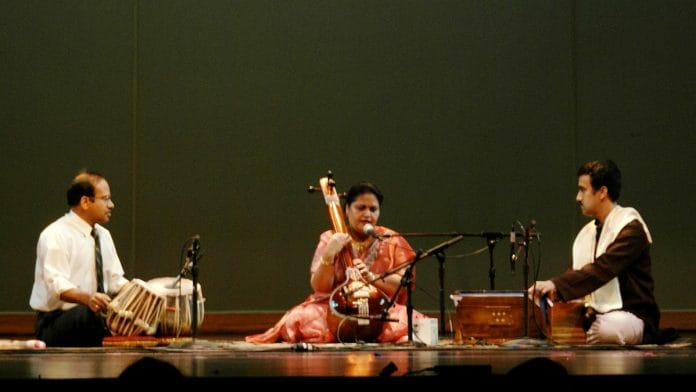Thank you dear subscribers, we are overwhelmed with your response.
R D Burman’s composition, Mehbooba Mehbooba from Sholay is arguably one of the most timeless floor-fillers from Bollywood. However, it is not really an original composition. The song bears a close, unmistakable resemblance to the song Say You Love Me by Greek singer-songwriter Demis Roussos. Similarly, the delightful Kaun Hai Jo Sapnon Mein Aya is a copy of Elvis Presley’s Margarita. There have been numerous other instances of hugely popular Hindi movie songs actually being based on the tune, beat, hook or phrase of other songs.
This has been going on for decades; long before MTV and the internet permitted us to identify the ‘original’ so we may sneer at the ‘copy’. It is fashionable to dismiss some of Anu Malik and Pritam’s work as plagiarized. However, I would argue that this isn’t related any lack of creativity. In fact, it has to do with our musical traditions.
Understanding the Khayal tradition
I am not going to call it ‘classical music’ or ‘shastriya sangeet’ because of the exclusion and cultural hierarchy this could denote. Let’s just call it ‘khayal’/‘khyal’ which literally translates to imagination or thought. The raags of the North Indian musical tradition are a set of rules or note structures within which the musician or singer has a great deal of freedom. A musician follows the rules but does their own ‘vistaar’ (expansion) of the raag for several minutes to well over an hour depending upon whether it is a ‘drut’ or ‘vilambit’ performance.
Raag Bhoopali (very often the first raag taught to a student of music) has 5 notes – sa re ga pa dha; all shuddha (no komal or teevr notes). How well and how aesthetically the musician interprets those notes depends upon the skill, creativity and virtuosity of that musician. From the very rudimentary bhajan Gaaiye Ganpati Jag Vandan that I was first taught in Mathuriben Khare’s class at age 8, to Kishori Amonkar’s ravishing rendition of Sahela Re, it is all Bhupali.
A more complex and difficult Raag such as Lalit, with its two Madhyam notes (sudhha and teevr) also has a similarly wide range of songs based on it. Pt Feroz Dastur’s Ghat Ghat Mein Raam Ramayya from Bhumika and Naushad’s Ek Shehenshah ne Banwake Haseen Taaj Mahal and Jagjit Singh’s Koi Paas Aaya Savere Savere —- all Lalit.
Different from Western traditions
A bandish (short song set in a particular raag) composed by Sadarang or Adarang in 18th century is still sung by contemporary singers. Individual singers do tweak these old compositions and different gharanas will also have their own variations. However, the basic note structures remain the same.
On the other hand, a symphony of Beethoven’s will be reproduced in very much the same way as it was originally written. A Tchaikovsky ballet or a composition by Bach is not ‘open to interpretation’ in the same way as Darbari, Miya ki Todi, Patadeep, Jaunpuri, Vibhaas or Shankara would be. Renditions of the same raag could be very, very different indeed depending upon the musician, their gharana and creativity/skill.
So when a Hindi film music composer ‘copies’ another composition, often they are just adapting it for an Indian audience. It is rare that the song is a straight lift. There are additions, refinements and changes made. I put it to you that R D’s Chura Liya is a superior composition to If Its Tuesday this must be Belgium. O P Nayyar’s Yeh Hai Bombay Meri Jaan is altogether more refined than the American folk song Clementine.
Plus, a song like Pyaar ki Pungi introduced me to the delightfully quirky Soosan Khanoom and other songs by the Iranian group Barobax. Thus, Barobax gained a whole new audience because Pritam borrowed from their song.
Is it all Bhairavi?
Bollywood songs like Jan Deep Jale Aana, Abhi Na Jaao Chhodkar, Laal Ishq and the Mehndi Hasan ghazal Ranjish Hi Sahi – what do they have in common? They are all based on Raag Yaman.
Composers in the Indian subcontinent have always functioned thus: they take musical phrases, songs, raags, folk ditties and they interpret, develop, refine, beautify these to create new compositions. We really ought not to see this as plagiarism – there is a lot of thought and creativity going into these new compositions.
Raag Bhairavi, traditionally sung at the end of a formal recital includes all 12 notes: seven shuddha swars, the 4 komal swars: rishabh, gandhar, dhaivat and nishad and one teevr madhyam. So in a sense, we could say all compositions are in Raag Bhairavi in one or another way.
Given that all musical compositions are based on the 12 notes, can songs really be plagiarized? Apparently, Ed Sheeran’s Shape of You is based on Raag Bhimpalasi and he has not been accused of plagiarizing to the best of my knowledge
- The author completed Sangeet Visharad in vocal music and has also learned khayal gayaki from various teachers in Ahmedabad, Pune and Vadodra.
These pieces are being published as they have been received – they have not been edited/fact-checked by ThePrint.


